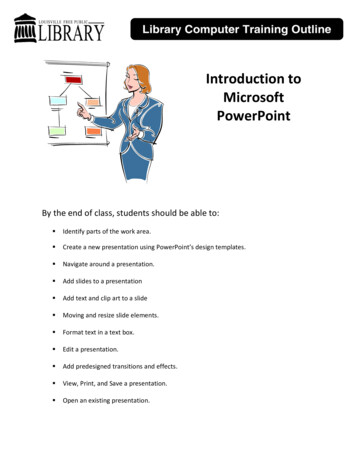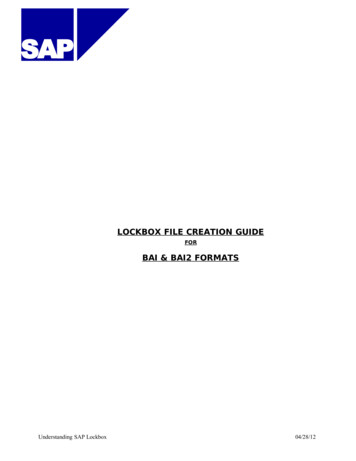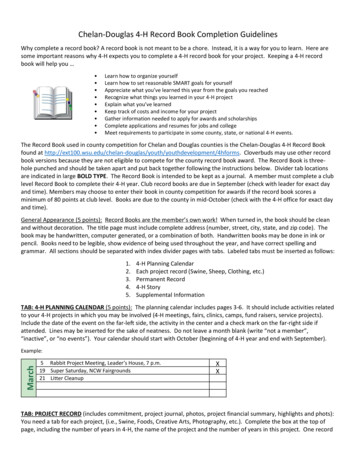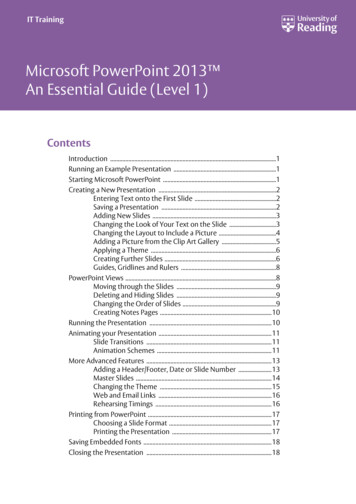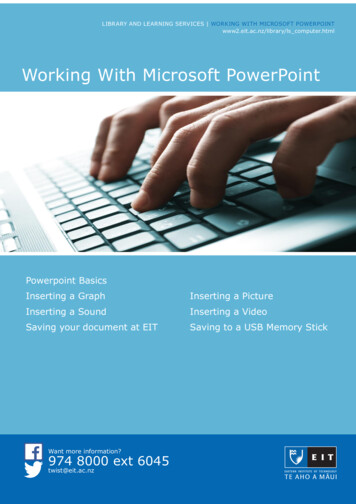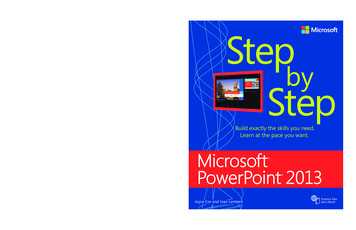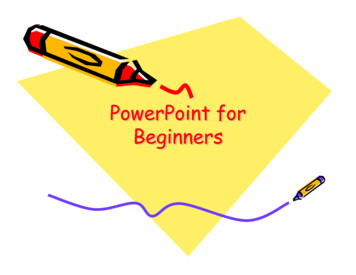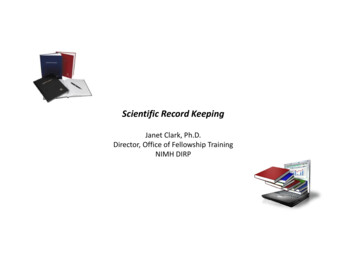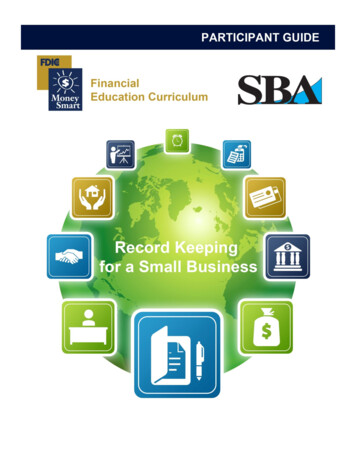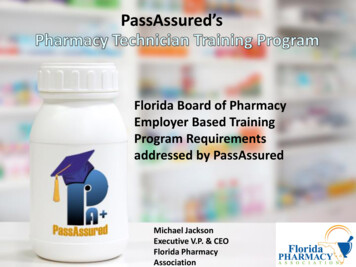
Transcription
2 Ways toPassAssured’sRecord PowerPointFrom within PowerPointFlorida Board of PharmacyEmployer Based TrainingProgram RequirementsFrom within Camtasia Studioaddressed by PassAssuredMichael JacksonExecutive V.P. & CEOFlorida PharmacyAssociation
Florida BOP’s Employer BasedTraining Program Requirements thatare addressed in the PassAssured’sPharmacy Technician Training Program (PTTP)1. Introduction to pharmacy and health care systems:a) Confidentialityb) Patient rights and Health Insurance Portability andAccountability Act (HIPAA)PassAssured addresses this in the HIPAA section. Individualsare to study HIPAA subsection and then take a test to follow.Please see next slide for sample portion of the HIPAAsubsection.
Florida BOP’s Employer BasedTraining Program Requirements thatare addressed in the PassAssured’sPharmacy Technician Training Program (PTTP)PassAssured’s HIPPA subsection sample:In 1996: The Health Insurance Portability and Accountability Act was passed referredas (HIPAA) HIPAA is the most significant piece of federal legislation to affect pharmacypractice since OBRA-90.The Privacy Rule component of HIPAA took effect on April 14, 2003, and was the firstcomprehensive federal regulation designed to safeguard the privacy of protectedhealth information (PHI).In The Big Picture, HIPAA is all about privacy of medical and health information. Mostimportant is how this information is processed, protected and handled by health plans,health care providers. (example: Pharmacies, Pharmacist, and Pharmacy Technician)and others who work with it. The Privacy Rule sets standards for how protected healthinformation should be controlled, by setting forth what uses and disclosures areauthorized or required and what rights patients have with respect to their healthinformation. The Privacy Rule prohibits the sharing of Individually Identifiable HealthInformation without a patient's permission unless the purpose of the disclosure ispermitted by regulation - such as for treatment, payment or health care operations.The intent is to protect the integrity, confidentiality and availability of electronicprotected health information from unauthorized access, alteration, deletion, ortransmission.
Florida BOP’s Employer BasedTraining Program Requirements thatare addressed in the PassAssured’sPharmacy Technician Training Program (PTTP)2. Pharmacy law:Federal lawb) Florida State lawc)Florida State rulesd) Pharmacy technician Florida rules and laws.PassAssured addresses “a” in the Federal Law section.PassAssured addresses “b,c, and d” in the Florida Law section.Individuals are to study Federal Law and Florida Law sectionsand then take tests to follow. Please see next 2 slides forsubsections covered in Federal Law and a sample portion of theFlorida Law section.a)
Florida BOP’s Employer BasedTraining Program Requirements thatare addressed in the PassAssured’sPharmacy Technician Training Program (PTTP)PassAssured’s Federal Law section content covered:Federal LawFederal Law focuses on legislation that affects the Pharmacy Industry. From Food and Drug Administration (FDA) laws to the PoisonPrevention Act (PPA), Federal Laws that have guided the Pharmacy industry are presented. The method used in determining a validDEA number is studied. The sub-section does not cover state and local laws. (State and local laws vary greatly, thus, providing thematerial in this product is not practical.) The national certification exams will only cover Federal Law.Sub-SectionsPharmacy Law and TimeThis sub-section provides different laws and legislation that affect the Pharmacy Industry, when they were enacted and theirimportance.Federal Law and DrugsThis sub-section discusses the importance of the Controlled Substance Act of 1970. This sub-section shows how this act regulatedthe manufacturing, distribution and dispensing of controlled substances based on abuse potential.Rules for Controlled SubstancesThis sub-section outlines filing procedures, maintaining records according to State and Federal Laws, and drug substitutionrequirements.DEA Number VerificationThis sub-section illustrates how a Doctor’s DEA Number is determined and its purpose. An interactive display gives the studentinstructions on how to determine if a DEA Number is valid.Schedule II DrugsThis sub-section discusses storage requirements for Schedule II Drugs.Investigational DrugsThis sub-section defines the four phases of Investigational Drugs.Each subsection has a quiz after completing the coordinating subsection video. After completing entire Federal Law section individualsare to complete the Federal Law section test.
Florida BOP’s Employer BasedTraining Program Requirements thatare addressed in the PassAssured’sPharmacy Technician Training Program (PTTP)PassAssured’s Florida Law subsection sample:Basic Laws and Rules for Pharmacy TechniciansA number of laws and rules that govern the behavior of pharmacy technicians and their role within a licensedpharmacy have changed over the years. A lot of information has been provided by the FPA on pharmacisttechnician laws and rules and will continue to develop with each new policy approved by the Board of Pharmacyand the Florida legislature. This means that the flow of information needs to be comprehensive, abundant andcontinuous. Our hope is that active membership in the Florida Pharmacy Association by both pharmacists andtechnicians will help to keep all best informed to answer questions from the multitude of non-member pharmacistsand pharmacy technicians who may find deficiencies noted in their records during routine inspections facilitatedby the Department of Health. In this article we will concentrate on the kinds of things that technicians can orcannot do in Florida. I will also share with you information about an organization called Pharmacy TechnicianCertification Board.Basic Things That the Prescription Department Manager Should KnowSince 1979, pharmacy technicians were acknowledged in Florida laws but there was very little definition on therole that technicians play or even a pathway towards recognizing the duties and functions of technicians. In 2009,there were significant changes in Florida laws that created registering of pharmacy technicians with the Board ofPharmacy. With this registration requirement came several Board of Pharmacy rules designed to define howmany technicians that a pharmacist could supervise, what duties that a technician could perform and what tasksthat a technician should not be doing. You already know about their registration requirements. The first rule isrelated to registered pharmacy technician ratios. Florida pharmacies are allowed one technician for eachpharmacist. A pharmacist may supervise additional technicians under certain conditions.*After studying the Florida Law section individuals are to complete the Florida Law section test.
Florida BOP’s Employer BasedTraining Program Requirements thatare addressed in the PassAssured’sPharmacy Technician Training Program (PTTP)3. Pharmaceutical- medical terminology, abbreviations,and symbols:Medication safety and error preventionb) Prescriptions and medication orders.PassAssured addresses #3 in Medical Review, Calculations,Pharmacy Operations, and the Study Aids. Please see next 3slides for further information.a)
Florida BOP’s Employer BasedTraining Program Requirements thatare addressed in the PassAssured’sPharmacy Technician Training Program (PTTP)PassAssured covers medical terminology:Medical ReviewMedical Review Section introduces to the future Pharmacy Technician toPharmacology. The study guide focuses on maintaining the proper instructional levelsuited for a Pharmacy Technician. The varied types of drugs, prescription types,medication dosage forms, and medical devices are discussed. Drug interaction on thehuman body’s major systems such as the central nervous system, peripheral nervoussystem, cardiovascular system and other systems of the human body is introduced.This study concentrates on commonly used drug classes that would be of mostconcern to the Pharmacy Technician.Sub-SectionsDoses and TerminologyDiscusses the different terms used in pharmacology. In-depth review of the differenttypes of medication dosages, such as tablets, caplets, liquids, creams, emulsions, etc.The sub-section also describes the different types of administration devices for certainmedications and dosages.
Florida BOP’s Employer BasedTraining Program Requirements thatare addressed in the PassAssured’sPharmacy Technician Training Program (PTTP)PassAssured covers abbreviations and symbols in Calculations and Study Aids:CalculationsPharmacy calculations are an essential function of the Pharmacy Technician. The PTTP’s calculation sectionprovides a refresher path through the aspects of Pharmacy mathematics. Many example calculations are doneusing different methods, thus, providing the student a choice for calculating Pharmacy math problems that bestsuits the individual’s needs. The Calculation section provides an excellent tool for learning Pharmacy math andthe calculations are performed ‘in motion’, with a timed audio presentation.Sub-SectionsAbbreviationsThe Pharmacy Industry exists in a world of abbreviations. Abbreviations uses in prescriptions are covered indetail. Emphases on abbreviations that have historically been misinterpreted are discussed. Reference listing ofPharmacy abbreviations is included.Roman NumeralsThe eight primary Roman Numerals are illustrated, with emphasis on ‘rules’ for adding and subtracting. RomanNumerals are widely used in Pharmacy.Study AidsThe Study Aids are an excellent way of teaching while having fun! The Study Aids were designed as anenhancement to the Medication Review Section. This part of the program will enable the student to becomefamiliar with over 200 drugs widely used in the market place. The Study Aids consist of flash cards and arecreated to allow the student to recognize and pronounce the medications reviewed all while having fun ‘playing’games. The games include Flashcards –“Top 200 Drugs”, “Memory Match”, “Roman Numerals”, “Sigs”,“Abbreviations”, and the additional Study Aids: “Study Table”, “Virtual Rx” and “Virtual Cash Register”. Drug namepronunciations as well as visual recognition of all medications reviewed are included.
Florida BOP’s Employer BasedTraining Program Requirements thatare addressed in the PassAssured’sPharmacy Technician Training Program (PTTP)PassAssured covers medication safety and error prevention and prescriptions and medication orders in Pharmacy Operations:Pharmacy OperationsPharmacy Operations is the core of the Pharmacy Technicians responsibilities. Day to day operations, interfacing with customers, maintaining patient records, andassuring the Pharmacy meets all State, Federal and local requirements are covered. Managing proper inventory control is vital in assuring continuing success of thePharmacy business. An overview of insurance claims and “Third Party” reimbursement is provided. Medication safety is a priority in dispensing medication topatients. Learning how to give appropriate change in covered in the Cash Register sub-section.Sub-SectionsBasic Facts in PharmacyThe Pharmacy Technician will need to be familiar with drug nomenclature. The three names given to each drug is reviewed. NDC codes, mnemonic codes, and theimportance of understanding different expiration date formats are discussed and illustrated. The various drug containers are illustrated. The different types ofcontainer closures and uses for each are reviewed. Auxiliary labels affixed to prescription bottles are reviewed.Assisting the PharmacistAcceptable medication prescribers are reviewed. Mailing prescription requirements, patient confidentiality, assisting the pharmacist, immunizations, The CombatMethamphetamine Epidemic Act of 2005, and how prescriptions can be transmitted to a Pharmacy and requirements for certain classes of drugs is discussed. Therequired information on a prescription and the process for patient refills is given.General Prescription DutiesMaintaining an accurate patient profile is crucial in providing medication to a patient. A well-maintained patient profile can prevent improper dispensing of medicationand adverse effects for medication. Details of what should be collected for a proper patient profile are illustrated. Brand versus generic, formularies, inventorycontrol, measuring and counting techniques, compounding and the different classes of balances, medication errors, and the step by step process of filling aprescription in a pharmacy are discussed.USP 795UPS 795 defines general information to support extemporaneous compound preparations that are of acceptable strength, quality and purity. Important USP 795terms and definitions are presented and explained. How-to Preparations are performed for suppositories, ointment, suspension and an enema.Medication Distribution and Inventory ControlDefinitions of key terms used in inventory management are provided. Ordering techniques and the proper receiving process of ordered items is reviewed. Expiredor discontinued stock processes and drug recall issues are illustrated. Point of Sale Management Systems, electronic prescribing, electronic medicationadministration record, and theft and drug diversion are discussed also.Third Party ReimbursementKnowledge of “Third Party” reimbursement is an ‘ever changing’ environment. A general overview of processes used for reimbursement and different payment planscurrently offered is illustrated. Formularies, generics, DAW codes, Affordable Care Act, Medicare, and Medicaid are reviewed.Medication SafetyMedication errors are covered in depth. Prevention strategies, causes of medication errors and where and why they occur, sound-alike and look-alike medications,Tall Man lettering, reporting medication errors to Medwatch and MERP, 5 rights of medication administration, e-prescribing, HITECH Act, iPLEDGE and othermedication safety programs,
Florida BOP’s Employer BasedTraining Program Requirements thatare addressed in the PassAssured’sPharmacy Technician Training Program (PTTP)4. Records management and inventory control:Pharmaceutical suppliesb) Medication labelingc)Medication packaging and storaged) Controlled substancese) Adjudication and billing.PassAssured addresses #4 in Federal Law and PharmacyOperations. Please see the next slide for more information.a)
Florida BOP’s Employer BasedTraining Program Requirements thatare addressed in the PassAssured’sPharmacy Technician Training Program (PTTP)PassAssured covers records management and inventory control(pharmaceutical supplies, medication labeling, medication packaging and storage,controlled substances, and adjudication and billing) in Federal Law and Pharmacy Operations:Federal LawRules for Controlled SubstancesThis sub-section outlines filing procedures, maintaining records according to State and Federal Laws, and drug substitution requirements.Schedule II DrugsThis sub-section discusses storage requirements for Schedule II Drugs.Pharmacy OperationsBasic Facts in PharmacyThe Pharmacy Technician will need to be familiar with drug nomenclature. The three names given to each drug is reviewed. NDC codes, mnemonic codes, and theimportance of understanding different expiration date formats are discussed and illustrated. The various drug containers are illustrated. The different types ofcontainer closures and uses for each are reviewed. Auxiliary labels affixed to prescription bottles are reviewed.Assisting the PharmacistAcceptable medication prescribers are reviewed. Mailing prescription requirements, patient confidentiality, assisting the pharmacist, immunizations, The CombatMethamphetamine Epidemic Act of 2005, and how prescriptions can be transmitted to a Pharmacy and requirements for certain classes of drugs is discussed. Therequired information on a prescription and the process for patient refills is given.General Prescription DutiesMaintaining an accurate patient profile is crucial in providing medication to a patient. A well-maintained patient profile can prevent improper dispensing of medicationand adverse effects for medication. Details of what should be collected for a proper patient profile are illustrated. Brand versus generic, formularies, inventorycontrol, measuring and counting techniques, compounding and the different classes of balances, medication errors, and the step by step process of filling aprescription in a pharmacy are discussed.Medication Distribution and Inventory ControlDefinitions of key terms used in inventory management are provided. Ordering techniques and the proper receiving process of ordered items is reviewed. Expiredor discontinued stock processes and drug recall issues are illustrated. Point of Sale Management Systems, electronic prescribing, electronic medicationadministration record, and theft and drug diversion are discussed also.Third Party ReimbursementKnowledge of “Third Party” reimbursement is an ‘ever changing’ environment. A general overview of processes used for reimbursement and different payment planscurrently offered is illustrated. Formularies, generics, DAW codes, Affordable Care Act, Medicare, and Medicaid are reviewed.
Florida BOP’s Employer BasedTraining Program Requirements thatare addressed in the PassAssured’sPharmacy Technician Training Program (PTTP)5. Interpersonal relations, communications, and ethics:Diversity of communicationsb) Empathetic communicationsc)Ethics governing pharmacy practiced) Patient and caregiver communicationPassAssured addresses #5 in Effective Communication andPharmacy Operations. Please see the next slide for moreinformation.a)
Florida BOP’s Employer BasedTraining Program Requirements thatare addressed in the PassAssured’sPharmacy Technician Training Program (PTTP)Effective CommunicationStudents realize the effectiveness on proper communications between customer/patient and the Pharmacy Technician. Withappropriate communication, correct questions are asked and issues as well as orders are efficiently processed as well asmisunderstandings and errors are avoided. A short quiz follows.Pharmacy OperationsPharmacy Operations is the core of the Pharmacy Technicians responsibilities. Day to day operations, interfacing with customers,maintaining patient records, and assuring the Pharmacy meets all State, Federal and local requirements are covered. Managingproper inventory control is vital in assuring continuing success of the Pharmacy business. An overview of insurance claims and “ThirdParty” reimbursement is provided. Medication safety is a priority in dispensing medication to patients. Learning how to give appropriatechange in covered in the Cash Register sub-section.Sub-SectionsBasic Facts in PharmacyThe Pharmacy Technician will need to be familiar with drug nomenclature. The three names given to each drug is reviewed. NDCcodes, mnemonic codes, and the importance of understanding different expiration date formats are discussed and illustrated. Thevarious drug containers are illustrated. The different types of container closures and uses for each are reviewed. Auxiliary labelsaffixed to prescription bottles are reviewed.Assisting the PharmacistAcceptable medication prescribers are reviewed. Mailing prescription requirements, patient confidentiality, assisting the pharmacist,immunizations, The Combat Methamphetamine Epidemic Act of 2005, and how prescriptions can be transmitted to a Pharmacy andrequirements for certain classes of drugs is discussed. The required information on a prescription and the process for patient refills isgiven.General Prescription DutiesMaintaining an accurate patient profile is crucial in providing medication to a patient. A well-maintained patient profile can preventimproper dispensing of medication and adverse effects for medication. Details of what should be collected for a proper patient profileare illustrated. Brand versus generic, formularies, inventory control, measuring and counting techniques, compounding and thedifferent classes of balances, medication errors, and the step by step process of filling a prescription in a pharmacy are discussed.
Florida BOP’s Employer BasedTraining Program Requirements thatare addressed in the PassAssured’sPharmacy Technician Training Program (PTTP)6. Pharmaceutical calculationsPassAssured addresses #6 in Calculations. Pleasesee next slide for more information.
Florida BOP’s Employer BasedTraining Program Requirements thatare addressed in the PassAssured’sPharmacy Technician Training Program (PTTP)CalculationsPharmacy calculations are an essential function of the Pharmacy Technician. The PTTP’s calculation section provides a refresher path through the aspects ofPharmacy mathematics. Many example calculations are done using different methods, thus, providing the student a choice for calculating Pharmacy math problemsthat best suits the individual’s needs. The Calculation section provides an excellent tool for learning Pharmacy math and the calculations are performed ‘in motion’,with a timed audio presentation.Sub-SectionsMetric SystemAudio, charts, graphic illustrations and text help files are used to provide the student with knowledge and reference tables for use in performing various conversions.The units of measurement for the Metric, Avoirdupois, and Apothecary systems are discussed.AbbreviationsThe Pharmacy Industry exists in a world of abbreviations. Abbreviations uses in prescriptions are covered in detail. Emphases on abbreviations that havehistorically been misinterpreted are discussed. Reference listing of Pharmacy abbreviations is included.Roman NumeralsThe eight primary Roman Numerals are illustrated, with emphasis on ‘rules’ for adding and subtracting. Roman Numerals are widely used in Pharmacy.Fractions, Decimals, & PercentThis review provides the basics of fractions, decimals and percent. The intensive use of ‘motion graphics’ support the audio driven lesson. A good understanding ofthis section will provide the student a basis for the remaining calculations topics.Temperature ConversionsTwo widely used methods for Fahrenheit – Centigrade temperature conversions are illustrated. The audio driven lesson uses ‘graphics in motion’ to provide clearlyexplained examples of typical pharmacy temperature conversions.Ratio ProportionsRatio proportion relationships are used to provide a means for reducing or enlarging chemical mixtures used in pharmacy. Determining the proper amount ofsolution to mix with drug active ingredients is covered.Quantities, Dilutions, & ConcentrationsQuantities, dilutions, & concentrations provide a review of unit of measurement for drug and expressions of quantity and concentration for drugs in drug products.Illustrations are discussed for the different methods for determining quantities of ingredients and concentration of drugs when preparing or dispensing drug products.Doses and Dose RegimenA review of methods of expressing doses and dosage regimens is given. The student will learn to calculate the amount of drug product to dispense and the numberof days’ supply from a dosage regimen. In addition, methods to calculate doses for pediatric patients are provided.Calculation of IV Flow RatesThe student will learn to determine the flow rate of an IV solution when given the total volume, total time of administration, and the drops delivered per ml by theadministration set.Powder VolumesDiscussions of powder volume concept are given. Learn how to calculate powder volume and how to use this information in reconstituting dry powders forsuspension or solution.PricingPricing methods support the needs of the pharmacy as a business enterprise. Our study guide will provide a review of various pricing methods used in retailpharmacy.
Pharmacy Technician Training Program (PTTP) PassAssured covers medical terminology: Medical Review Medical Review Section introduces to the future Pharmacy Technician to Pharmacology. The study guide focuses on maintaining the proper instructional level suited for a Pharmacy Technician
